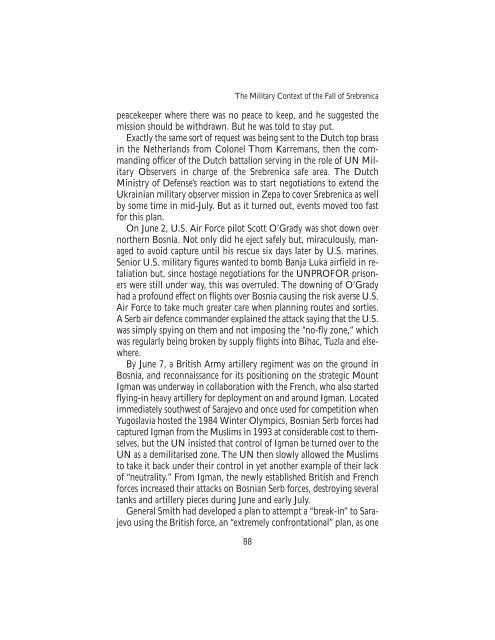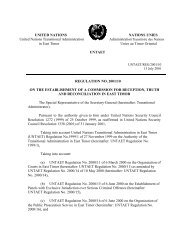The Srebrenica Massacre - Nova Srpska Politicka Misao
The Srebrenica Massacre - Nova Srpska Politicka Misao
The Srebrenica Massacre - Nova Srpska Politicka Misao
Create successful ePaper yourself
Turn your PDF publications into a flip-book with our unique Google optimized e-Paper software.
<strong>The</strong> Military Context of the Fall of <strong>Srebrenica</strong><br />
peacekeeper where there was no peace to keep, and he suggested the<br />
mission should be withdrawn. But he was told to stay put.<br />
Exactly the same sort of request was being sent to the Dutch top brass<br />
in the Netherlands from Colonel Thom Karremans, then the commanding<br />
officer of the Dutch battalion serving in the role of UN Military<br />
Observers in charge of the <strong>Srebrenica</strong> safe area. <strong>The</strong> Dutch<br />
Ministry of Defense’s reaction was to start negotiations to extend the<br />
Ukrainian military observer mission in Zepa to cover <strong>Srebrenica</strong> as well<br />
by some time in mid-July. But as it turned out, events moved too fast<br />
for this plan.<br />
On June 2, U.S. Air Force pilot Scott O’Grady was shot down over<br />
northern Bosnia. Not only did he eject safely but, miraculously, managed<br />
to avoid capture until his rescue six days later by U.S. marines.<br />
Senior U.S. military figures wanted to bomb Banja Luka airfield in retaliation<br />
but, since hostage negotiations for the UNPROFOR prisoners<br />
were still under way, this was overruled. <strong>The</strong> downing of O’Grady<br />
had a profound effect on flights over Bosnia causing the risk averse U.S.<br />
Air Force to take much greater care when planning routes and sorties.<br />
A Serb air defence commander explained the attack saying that the U.S.<br />
was simply spying on them and not imposing the “no-fly zone,” which<br />
was regularly being broken by supply flights into Bihac, Tuzla and elsewhere.<br />
By June 7, a British Army artillery regiment was on the ground in<br />
Bosnia, and reconnaissance for its positioning on the strategic Mount<br />
Igman was underway in collaboration with the French, who also started<br />
flying-in heavy artillery for deployment on and around Igman. Located<br />
immediately southwest of Sarajevo and once used for competition when<br />
Yugoslavia hosted the 1984 Winter Olympics, Bosnian Serb forces had<br />
captured Igman from the Muslims in 1993 at considerable cost to themselves,<br />
but the UN insisted that control of Igman be turned over to the<br />
UN as a demilitarised zone. <strong>The</strong> UN then slowly allowed the Muslims<br />
to take it back under their control in yet another example of their lack<br />
of “neutrality.” From Igman, the newly established British and French<br />
forces increased their attacks on Bosnian Serb forces, destroying several<br />
tanks and artillery pieces during June and early July.<br />
General Smith had developed a plan to attempt a “break-in” to Sarajevo<br />
using the British force, an “extremely confrontational” plan, as one<br />
88



